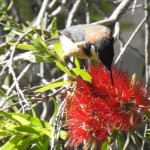Wildlife species need to move for a number of reasons if they are to persist in any region, including the Scenic Rim, whether daily between feeding and resting sites (wallabies, bats, many birds), seasonally or nomadically to ensure they have enough resources for survival and breeding, to escape major events such as extreme drought or severe wild fires, to find mates (and thus guard against inbreeding) or, as young adults, to establish new territories.
A survey of the presence of squirrel gliders, funded by the Scenic Rim Regional Council, made it clear that although the forests of our mountains are conserved in a number of Protected Areas, the open forests and woodlands of our valleys (the preferred habitat of this species, unlike other local gliders) are highly fragmented.
We thus called for donations and volunteers to start filling some of the gaps, not only for squirrel gliders but also koalas, glossy black cockatoos, understory birds, native bees and butterflies. WPSQ Central raised $5000 for us to begin to purchase plants, tree guards and fencing to protect young plants from cows and other grazing and browsing animals.
Later we applied for a federal Community Environment Program grant, which our federal MP Mr Scott Buccholz supported us for, and received over $10,211 to continue and expand this work.
We received another grant of $48,000 in 2021 through the Landcare Bushfire Recovery Grant program, to expand our corridors project, this time extending our scope to include providing food plants along riparian strips for frugivorous birds and fruitbats that need to move from the upland forests in lean seasons and when threatened by fires. Click here for an article about this..
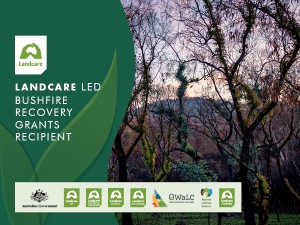
The donations and grants and the help of various volunteers, including some of the landowners, has enabled us to provide plants and fencing materials for many properties, hold educational workshops, and purchase new equipment such as additional motion-sensing cameras.
We have now spent the entire grant money, but that doesn’t mean the end of the corridors project. We are continuing to conduct fauna surveys to compare with future surveys, to investigate whether the project is indeed increasing the numbers and diversity of wildlife along the corridor routes.

Our original plan for corridors
Also visit:
- https://scenicrim.wildlife.org.au/projects/wildlife-corridors-for-the-scenic-rim/wildlife-corridor-plans/ plans for corridors
- https://scenicrim.wildlife.org.au/wildlife/tools-for-conservation/
- https://scenicrim.wildlife.org.au/projects/wildlife-corridors-for-the-scenic-rim/planting-for-wildlife-in-the-corridors/
- https://scenicrim.wildlife.org.au/news-and-events/review-of-2012-2013/wildlife-corridors-workshop-february-2020/
- https://scenicrimwildlifecorridor.wordpress.com (for volunteering)
- https://wildlife.org.au/queensland-glider-network/#QGN_projects (WPSQ’s Glider Network)
Why corridors?
A few years ago our main theme for the year was why animals need to move, .
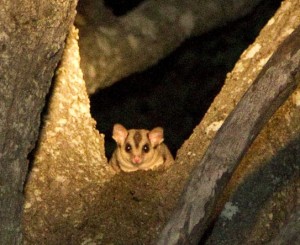
First sighting on our surveys: a squirrel glider on the Destiny Eco-cottage property near Boonah. (photo by Linda Cross)
which includes aspects the animals are actively involved in seeking:
- To reach sleeping/resting and feeding/drinking areas
- To find new feeding places as resources diminish.
- To find a new territory
- To migrate north-south between breeding areas and over-wintering areas
- To find a mate.
A few years ago Keith McCosh of Scenic Rim Regional Council suggested we search for squirrel gliders, which (unlike the the other gliders in our region) tend to be found in low-altitude open forests and woodlands. Squirrel gliders are not yet threatened, but their habitat is not well protected by national parks or other conservation areas, and it is increasingly fragmented, making it difficult for gliders and other animals to move from one patch of habitat to another. We accordingly applied for and received grants, conducted quite a few surveys and mapped out areas where gliders were detected, and where corridors could be useful.
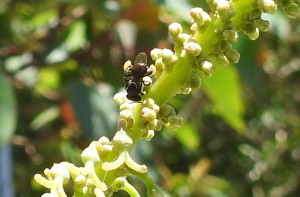
Although focussing initially on squirrel gliders, we have been aiming at corridors that are suitable for other wildlife using similar habitats, including: koalas, bettongs, birds that need understory shrubs and are not strong flyers (e.g. fairy-wrens) or whose populations have been dwindling (glossy black cockatoos, grey-crowned babblers), lizards, native bees and butterflies.
Different species have different needs:
- Gliders can glide between trees and habitat patches
- Birds, bats, butterflies and bees can fly between them
- Bettongs, bandicoots, dasyurids, echidnas, lizards, frogs and many others can’t
- Some birds very readily fly across cleared areas such as open paddocks
- Others hesitate to leave the shelter of the forest (and may never fly high enough to see other habitat patches)
- Some birds (noisy miners, crows, kookaburras, butcherbirds) do very well where there are just trees and short grass but are predatory or aggressive towards small birds that need thickets of understory shrubs for protection
- Although bees can fly between habitat patches, they may need some flowers to feed from every 100 or 200m.
- Butterflies prefer to fly where there are at least some understory shrubs for shelter when needed
- Koalas can walk quite long distances between trees, but while doing so they are more vulnerable to attacks by dogs and collisions with vehicles
Where are the present and future corridors?

We originally developed a plan in cooperation with the Scenic Rim Regional Council. Our former environment officer, Keith McCosh recommended consolidating the “hubs” (Kooralbyn/Josephville, Mont Alford/Wallaces Creek, Birnham, lower Duck Creek, and Maroon/Mt Barney) as secure glider habitat as well as establishing corridors. Corridors will especially lead out from the Kooralbyn/Josephville area to other areas where they have been seen – especially south to the Maroon area, west to Boonah area and north to Birnham Range, and from there via Kerry Road to Duck Creek Road, where there are good populations. [As Kooralbyn is more or less in the centre of some major corridors, we thought of this as a “hub” with radiating spokes (corridors) but have since been referring to all the large habitat remnants as hubs.]
A corridor through low-altitude areas nearer the NSW border is also being considered, as well as some connections between rainforest and riparian open forest, with some panting of fleshy-fruited rainforest trees and shrubs that are known to grow naturaly in some valleys in the region.
Plantings and fence construction have been achieved on a number of properties along corridor routes, and it is anticipated that glider poles will be used across some paddocks where plantings are not wanted by the landowner, and that we will also be planting on Council land to fill some gaps.
Financial assistance
Wildlife Queensland (head office) raised $5000 towards equipment, plants, workshops etc. Our first purchase from this grant entails three motion-sensing cameras (with infra-red for night time – no white flashes to startle animals)
The Communities Environment Program (federal government) also provided us a grant of $10,211 largely to provide fencing and other protection between plantings and grazing cattle and other animals.
We received a further $48,000 from Landcare to expand and extend our project, including corridors for rainforest birds (especially the critically endangered Coxen’s figparrot, but also bowerbirds, rifle birds and fruit doves and others) that move seasonally between highlands and valleys. Yes, they can fly, and some will readily fly over open paddocks, but others are hesitant to leave the shelter of the forest, and because of extensive clearing in the past they have little to eat in the valleys.
Plans for the hubs
- Surveys of gliders and other wildlife throughout the coming couple of years as baseline data. This will include standardised searches in mornings and evenings (for species active at differing time of day), additional more opportunistic searches, and seeing of motion- sensing cameras. We will provide check sheets for particular species, but other sightings will also be recorded. Native bees or butterflies on flowers or butterflies laying eggs should be photographed both for identification of the species and for a record of which plants they are using. Use of different plants by the mammals and birds will also be recorded (e.g. which trees or shrubs are gliders eating sap or gum from). See here for details.
- Enhance with additional plantings and nest boxes where appropriate
- Future surveys (using same methodologies as above) to see what is working: possibly after 5 years and 10 years.
Plans for the corridors
- Identify gaps and where corridors could really be installed
- Find out what is possible (willing landowners, council permission)
- Plan the plantings accordingly (sometimes along an ideal route, sometimes with deviations)
- Conduct surveys as for hubs
- Coordinate volunteers and land-owners
- Decide on which trees, shrubs and other plants are appropriate and agreeable to land-owners along each route
- Prepare ground and protection from grazing animals where necessary
- Plant the trees and other plant species
- Return as often as necessary opening on conditions (e.g. rainfall) to inspect, water the plants, remove weeds close to them, and record survival rates
- Conduct further surveys in future years to assess use by wildlife species
What we are planting and will continue to plant
- Trees for squirrel gliders to glide between
- Trees and shrubs for glider food, especially winter- flowering
- Trees and shrubs for fruit-eating birds, especially along watercourses leading from mountain forests to lower altitudes, and especially winter-fruiting
- Koala food trees
- Food-plants for butterfly larvae
- Flowers for native bees Other wildlife-friendly plants
A nice illustration of plants for native bees can be found here: https://drive.google.com/file/d/13EkHtot5zo–KKMgCsK4SmtZyDbh7P3e/view?usp=drivesdk
Other factors we’ve considered in choices:
- Locally native species (preferably species occurring naturally in the localities the corridors run through, but there are a few useful species that occur in other parts of the Scenic Rim or very close to it)
- Relatively fire-resistant (everything will burn in a catastrophic fire, but some plants are considerably more fire-resistant than others).
- Drought and frost resistant (more likely to survive through stressful times, and involve us in less work)
Click here for a working list of plants we’re recommending for planting.
Click here for some information on equipment for surveys and habitat restoration/enhancement
A call for volunteers
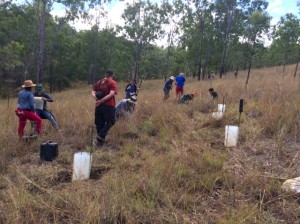
Many thanks to those who have alway indicate their willingness to help in various ways, and especially to those who have already done so. Very much appreciated.
If you have not done so but are interested, please let us know if you can:
- Offer part of your land for planting
- Provide materials (tree guards, nesting boxes etc.)
- Help with planting, weeding and watering?
- Help with fencing?
- Help with surveys?
- Help with collating information?
- Not actually do much right now but would like to be updated by an email newsletter
Please register your interest at https://cutt.ly/corridor
Remember safety is important:
- It is best for volunteers to work in pairs or small groups, both as protection against undesirable encounters, especially at night, and for one to assist or call for help if others are injured (some accidents can happen very unexpectedly)
- A first aid kit should always be available
- There should be at least one mobile phone to call for help, and preferably everyone should have a phone to contact each other if separated
- Volunteers should avoid walking through long grass where snakes may be present but not obvious (they don’t see us as prey, and generally keep out of our way, but they don’t like being trodden on)
Acknowledgments
We have many people to thank.
- The Scenic Rim Regional Council, who funded many of our glider surveys, and is giving us free trees and other wildlife-friendly plants.
- Wildlife Queensland headquarters, who have raised $5000 toward the glider corridor project.
- The Communities Environment Program, Department of Industry, Innovation and Science, which have now given us an additional grant of over $10,200. Thanks to Federal MP Scott Buccholz for recommending our project to them
- Federal LandCare, who granted us $48,000 to continue our work
- Boonah Landcare and Land for Wildlife (Scenic Rim RegionalCouncil) who have been very supportive in a number of ways
- Various experts who have spoken at our workshops, especially Dr Ross Goldingay, with extensive experience of research on gliders and their use of glider poles
- Energex, who have offered us used telegraph poles as glider poles
- Department of Transport and Main Roads, whose environment officer is supportive of the idea of careful roadside plantings (where we can also deter wildlife from crossing major roads) and well-planned erection of poles for gliders and overpass ladders for other arboreal mammals
- Various volunteers who have assisted with surveys and landowners who have allowed us to erect motion-sensing cameras or bought their own cameras to monitor wildlife on their properties
- Those who have offered to volunteer in future tree-planting and aftercare, citizen-science monitoring, construction of nesting boxes and other aspects of the project
- Healthy Land and Water, WWF and others who have expressed support for the project
Public Workshops
Details of a 2019 wildlife corridors workshop can be viewed here.
Details of our workshop 8th February 2020, which was attended by about 40 delegates despite heavy rain, have largely been incorporated into the details on this page.
Let us know if you would like to be on an email list for updates.
Click here for a working list of plants we’re recommending for planting.
Some further reading
General
A thesis on effectiveness of corridors https://eprints.qut.edu.au/16039/
Corridors in Australia
Considering our role in respect to the Great Eastern Ranges (“The Great Eastern Ranges Initiative (GER) brings people and organisations together to protect, link and restore healthy habitats over 3,600km, from western Victoria through NSW and the ACT to far north Queensland.”) https://www.ger.org.au/home
National wildlife corridors plan “The National Wildlife Corridors Plan is the Australian Government’s framework to retain, restore and manage ecological connections in the Australian landscape. It lays the foundation for a new, collaborative, whole-of-landscape approach to biodiversity conservation, one based on voluntary cooperation and the efforts of communities, landholders, governments and industry. The role of the Australian Government is to enable and coordinate the efforts of all participants. The Corridors Plan outlines the Australian Government’s vision whereby a diversity of land tenures and land use types will contribute to wildlife corridors. It is designed to guide and support individuals, private landholders and managers, community groups, policy makers, planners and natural resource managers to develop and manage corridor initiatives. The rights landholders have under the law to control and enjoy their property, control access to their property and legally dispose of their property in part or in whole are not altered or affected by the Corridors Plan.” https://www.environment.gov.au/topics/biodiversity/biodiversity-conservation/wildlife-corridors/what-are-wildlife-corridors
Fauna Sensitive Road Design (Queensland Government) – Wildlife Corridors Download pdf FSRD_4_WildlifeCorridors
Corridors in ne NSW (NSW Government)https://www.environment.nsw.gov.au/resources/nature/landholderNotes15WildlifeCorridors.pdf
Habitat creation in Mosman, Sydney https://scenicrim.wildlife.org.au/projects/wildlife-corridors-for-the-scenic-rim/
Review of corridors in logging areas in Australia https://www.publish.csiro.au/WR/WR9940323
A wildlife corridor along railway in Melbourne https://www.abc.net.au/gardening/factsheets/a-wildlife-corridor/9429290
Riparian (river-side) corridors. Martin, TG, McIntyre, S Catterall, CP Possingham HP 2006. Is landscape context important for riparian conservation? Birds in grassy woodland. – Biological Conservation 127: 201-214
Corridors for vertebrates
Bird corridors https://www.birdsinbackyards.net/Fragmentation-and-Wildlife-Corridors
Edge effects on Australian forest birds: Catterall, CP, Green, RJ, Jones, DN 1991, Habitat use by birds across a forest-suburb interface in Brisbane: implications for corridors. Nature conservation 2: 247-258
Corridors for invertebrates
Corridors for invertebrates https://conservationcorridor.org/2020/02/how-do-you-build-a-corridor-for-invertebrates/
If cities like New York can provide corridors for butterflies and bees, we certainly can! https://www.nytimes.com/2019/10/26/nyregion/green-roofs-nyc.html
Nation pollinator counts. (We can incorporate this into our monitoring) https://wildpollinatorcount.com/resources/run-count/





